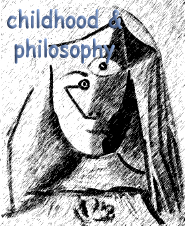entre cercas, brincadeiras e feitiços: os conflitos e as apropriações do território por crianças e jovens quilombolas
DOI:
https://doi.org/10.12957/childphilo.2020.48351Palavras-chave:
infância, comunidade quilombola, territórioResumo
O Brasil passou por um longo processo de colonização que ainda deixa marcas violentas nas formas de se relacionar com os povos quilombolas, produzindo a desvalorização de seus conhecimentos e culturas. As vidas de crianças e jovens quilombolas ficaram invisibilizadas diante de um saber científico que usou referências de autores europeus e as classes médias urbanas como modelo. Neste texto, apresentamos os resultados de uma pesquisa-intervenção realizada entre 2017 e 2019, com cerca de trinta crianças e jovens moradores da comunidade quilombola de Cafuringa, em Campos dos Goytacazes - RJ. Buscamos compreender como as experiências de infância e juventude se constituem a partir das relações que crianças e jovens estabelecem com o território, seus usos e apropriações, e os modos de subjetivação diante dos conflitos vivenciados na comunidade. As crianças se apropriam do território através das brincadeiras coletivas realizadas ao ar livre, em que exploram os espaços, interagem com a terra, bichos, plantas e árvores. Para elas, estes elementos podem ser “enfeitiçados”, “assombrados” e guardar algo de “sagrado” e, ao mesmo tempo em que fascinam, também geram medo. Essas formas de se relacionar com o território entram em conflito com a “fazenda” e o haras, que fazem fronteira com o quilombo, que consideram a terra como um negócio, os animais e as plantas como mercadorias. Os estranhamentos de crianças e jovens diante da cerca elétrica colocada pelo haras, simbolizando o uso privado da terra, as desigualdades sociais e as discriminações raciais vividas em seus cotidianos nos fazem questionar sobre o projeto de civilização construído na modernidade.
Downloads
Referências
ACSELRAD, Henri. Conflitos Ambientais no Brasil. Rio de Janeiro: Relume Dumará, 2004.
ALANEN, Leena. Estudos feministas/estudos da infância: paralelos, ligações e perspectivas. In: Castro, L. R (org). Crianças e jovens na construção da cultura. Rio de Janeiro: NAU, 2001, p. 69-92.
ARENDT, Hannah. A condição humana. Rio de Janeiro: Forense Universitária, 2005.
ARRUTI, João Maurício. Introdução: territórios negros In: Arruti, J. M. (Org) Territórios negros do Rio de Janeiro: história, antropologia e alternativas jurídicas. Rio de Janeiro: UERJ, 2002, p. 4-13.
BORBA, Angela Meyer. A participação social das crianças nos grupos de brincadeira: Elementos para a compreensão das culturas da infância. Revista Educação em Foco, v.13, n. 2, p. 139-156, 2009.
BRASIL. Decreto nº 4887, de 20 de novembro de 2003. Diário Oficial da União, Brasília, DF, 21 nov. 2003. Disponível em: http://www.planalto.gov.br/ccivil_03/decreto/2003/D4887.htm. Acesso em: 15 jan. 2020.
BROUGÈRE, Gilles. Brinquedo e Cultura. São Paulo: Cortex. 2010
BURMAN, Erica. Deconstructing Developmental Psychology. Londres: Routledge, 2008.
BUTLER, Judith. Vida Precaria: el poder del duelo y la violencia. Buenos Aires: Paidós, 2006.
CASTRO, Lucia Rabello de. Da invisibilidade à ação, crianças e jovens na construção da cultura. In: Castro, L. R. (Org.), Crianças e jovens na construção da cultura. Rio de Janeiro: Nau, 2001, p.19-46.
CASTRO, Lucia Rabello de. O futuro da infância e outros escritos. Rio de Janeiro: 7Letras, 2013.
COHN, Clarice. Concepções de infância e infâncias. Um estado da arte da antropologia da criança no Brasil, Civitas, v.13, n. 2, p. 221-244, 2013.
COMISSÃO PASTORAL DA TERRA – CPT. Conflitos no Campo Brasil 2018. Goiânia: CPT, 2019.
DESCOLA, Philipe. Outras naturezas, outras culturas. São Paulo: Editora 34. 2016.
ELIADE, Mircea. O sagrado e o profano: a essência das religiões. São Paulo: Martins Fontes, 2001.
FANON, Franz. Peles negras, máscaras brancas. Salvador: EDUFBA, 2008.
FANON, Franz. Os condenados da Terra. Minas Gerais: Editora UFJF, 2005.
GOBBI, Márcia; FINCO, Daniela. Meninas e meninos em assentamento do MST: representações e diferentes modos de ver e sentir da infância do campo. In: SILVA, I. O. ; SILVA, A. P. S.; MARTINS, A. A. (Org.). Infâncias do Campo. Belo Horizonte: Autêntica, 2013, p. 59-76.
FAVRET-SAADA, Jeanne. Ser afetado. Cadernos de Campo, 13, p.155-161, 2005.
GUSMÃO, Denise & JOBIM E SOUZA, Solange. A estética da delicadeza nas roças de minas: sobre a memória e a fotografia como estratégia de pesquisa-intervenção. Psicologia & Sociedade, v. 20, p. 24-31, 2008.
KRENAK, Ailton. Ideias para adiar o fim do mundo. São Paulo: Companhia das letras, 2019.
MBEMBE, Achile. Necropolítica: biopoder, soberania, estado de exceção, política de morte. São Paulo: n-1edições, 2018.
PENHA, Geneci Maria da. A voz do tambor: a Noinha e o jongo. Campos dos Goytacazes, 2010.
QVORTRUP, Jeans. Nove teses sobre a infância como um fenômeno social. Proposições, v. 22, n. 1, p.199-211, 2011
SANTOS, Milton. Por uma outra globalização: do pensamento único à consciência universal, São Paulo: Editora Record, 2008.




